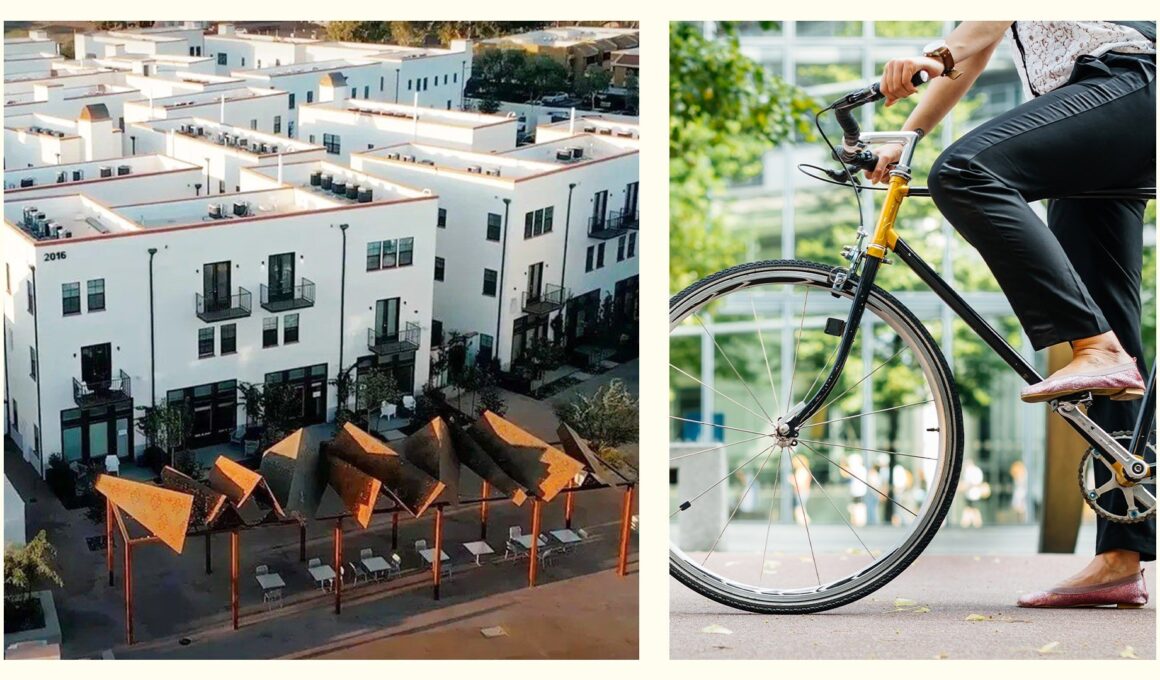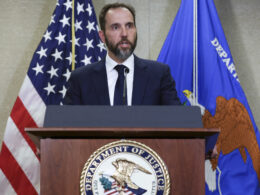Pete Adeney, like most people, hates getting stuck in traffic. So when he heard about a new community where he wouldn’t need to own a car at all, he was intrigued.
Just 15 miles from Tempe, AZ, Culdesac is billed as the first car-free community built “from scratch” in the U.S. In 2023, nearly 40 residents moved in, and there were plans to expand to 1,000 residents in 760 apartments on 17 acres by 2025.
Currently, rentals go for $1,500 to $2,280 per month for one- or two-bedroom apartments. Short-term, fully furnished rentals are also offered, although no units are for sale yet.
But is living without a car realistic? In December, Adeney decided to find out by moving to Culdesac.
At the time, he was living in Denver with his teenage son, but they were eager to escape the area’s bitter winter and try a more active lifestyle that Culdesac could provide.
“My son and I both moved there for the experience together,” Adeney says.

(Realtor.com)
The benefits of car-free living
For four months, Pete rented a furnished, two-bedroom apartment in Culdesac and lived there full time, while his son alternated between Colorado and Arizona. At first, they were worried about how they’d get around and if they’d have access to everything they needed, but these fears were quickly laid to rest with the many auto-free travel options at their disposal.

(Realtor.com)
“They do a great job of providing multiple ways to get around, so you can live there without owning a car—a light-rail stop right at the corner of the neighborhood, plus e-bikes, and even a car-share station right on site, stocked with brand-new Chevy Bolt EVs,” Adeney says.
Soon after moving in, he and his son came to love that they could avoid getting behind a wheel all the time.
“I have always been a big fan of living a life with more walking and biking and less car dependence,” he says. “I like to set myself up to be close to everything that I like to do on a regular basis: work, friends, groceries.”
Adeney, a personal finance blogger and founder of Mr. Money Mustache, also notes that car-free living comes with many other benefits. For one, for residents who don’t own a car don’t need to pay for gas or insurance. Plus, “it helps you get in better shape by reducing your need to drive,” he points out.
Two of Adeney’s favorite amenities at Culdesac are the lush grounds and the two-story fitness center.
“Culdesac itself is really nicely laid out with great architecture, courtyards, and gardens,” he says. “As a fitness enthusiast, I had a special appreciation for the on-site gym, which is the best and most complete facility I’ve ever seen in an apartment complex.”

(Pete Adeney)

(Realtor.com)
But Adeney also points out that they never felt trapped in Culdesac, with plenty of hiking, biking, and other attractions nearby.
“We loved being within easy biking distance of downtown Tempe and Papago Park and having easy access to a bunch of other hikeable mountains in the Phoenix area as well,” Adeney says.

(Pete Adeney)
Why car-free living creates a sense of community
Nate Dicochea, the leasing manager for Culdesac, also lived there when it opened and was impressed by the convenience factor of not needing to drive everywhere.
“When you’re cooking and run out of an ingredient, you can just hop down to the store and grab it in three minutes, rather than having to take the time to drive all the way to a faraway store and back,” he says.
Culdesac co-founder and CEO Ryan Johnson believes car-free living offers much more than convenience, though. He thinks America’s car-centric culture has led to people feeling disconnected from their communities. Culdesac, by contrast, “builds in” social interactions in the form of friendly bump-ins with neighbors.
“Culdesac embodies our vision for people-first living, creating vibrant connections among residents, businesses, and the broader community,” Johnson says.

(Realtor.com)
A neighborly environment is also cultivated via local social events such as movie nights and farmers markets.
“There’s always something to do and some place to go,” Dicochea remarks.
Adeney agrees that he and his son loved strolling through Culdesac’s main drag, which includes a James Beard-nominated restaurant, Korean convenience store, and more that create “a pretty interesting mini-downtown feeling”.

(Realtor.com)
Why car-free living appeals to college students
Culdesac is particularly popular among college students, who often don’t own a car anyway.
“Currently, I do not have a car,” says 19-year-old Adrian Rodriguez, a student at Arizona State University, which is a short bike ride from Culdesac, where he’s lived since January 2024.
“I fully understand that living in a car-free community may not be for everyone; but for me, it’s perfect,” he says.
Rodriguez resides in one of the live/work units, with a one-bedroom apartment in the back and a retail store in the front where he sells his sustainable clothing line, Ito.
“My retail space is pretty separate from my living space,” he says. “My bedroom and my bathroom make up about half of my unit, and my retail space and my kitchen take up the other half. I’m studying entrepreneurship and fashion design, and to have a place to live close to campus while also getting a retail space has been a game changer—an opportunity that otherwise wouldn’t be available to me for possibly years to come.”
Since opening his store in March, he’s learned a lot from the other shop owners nearby.
“I am very happy to say that I am close with all of the retailers here at Culdesac,” he says. “They’re all awesome people who have taught me a lot about running a business. There is a genuine community here of residents and business owners that I have yet to see anywhere else in Arizona.”
Could car-free living catch on?
Culdesac is now eyeing expansion into Mesa, AZ, and Atlanta, but it remains to be seen whether such communities will catch on broadly.
“The emergence of car-free built environments will be an interesting trend to follow,” says Realtor.com economist Ralph McLaughlin. “A large majority of the U.S. has been developed around the automobile, so households have had very little choice to vote with their feet in favor of car-free neighborhoods.
“Surely, some households will be in favor of such car-free spaces, but it will be interesting to see if price growth in these areas outpaces traditional neighborhoods over time. As alternative modes of transport become more popular, it’s quite possible car-free neighborhoods could be a design trend that becomes a more permanent stable in U.S. cities.”
Adeney (who negotiated a discounted press rental rate and blogged about his experiences) says the four months he spent in Culdesac were so enjoyable, he’d consider moving back there at some point.
“We Americans get a little nervous when anyone talks about alternatives to car transport,” Adeney says. “But at the root, all it means is more nice things a lot closer to your home—and who doesn’t want that?”








